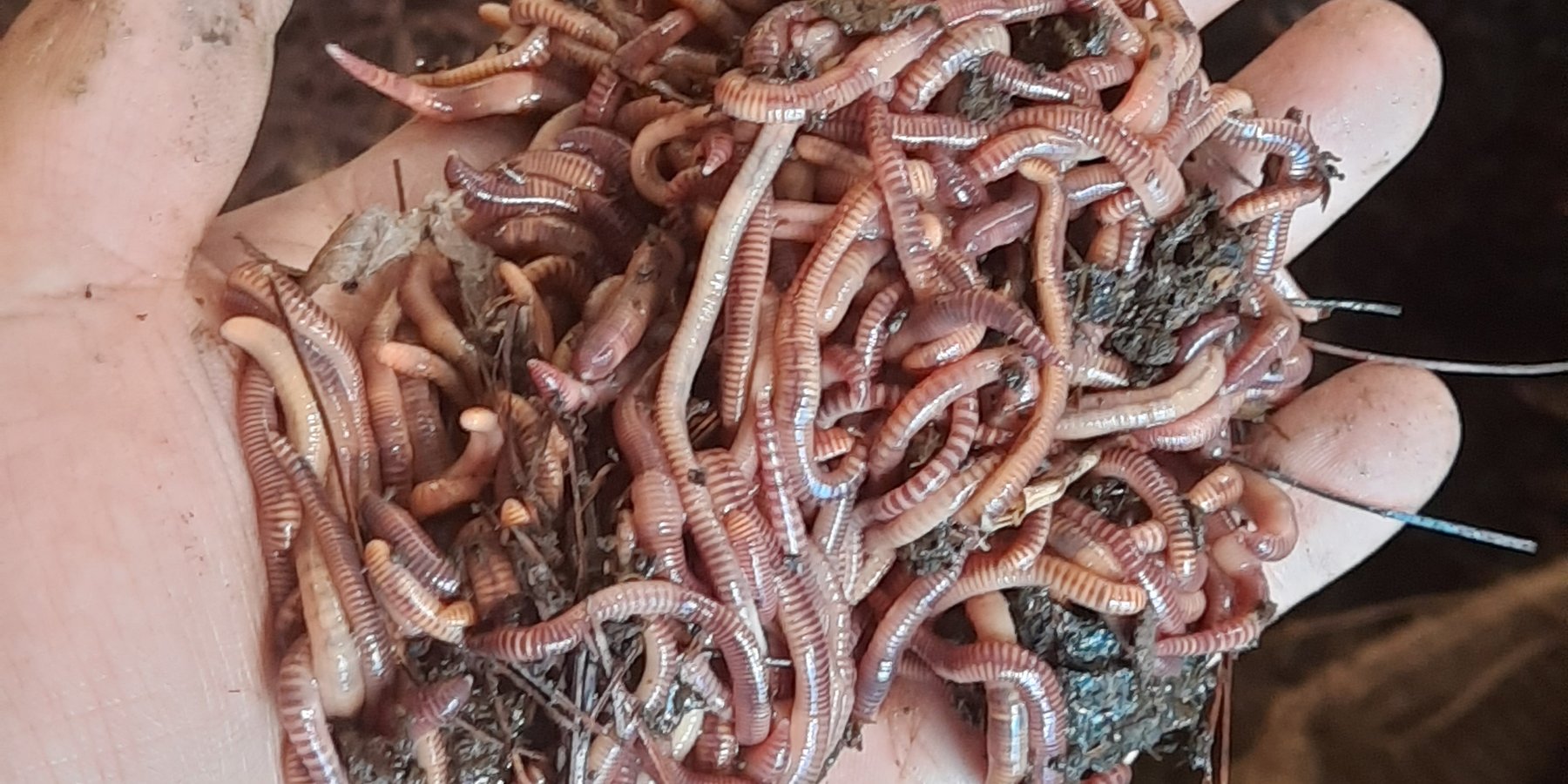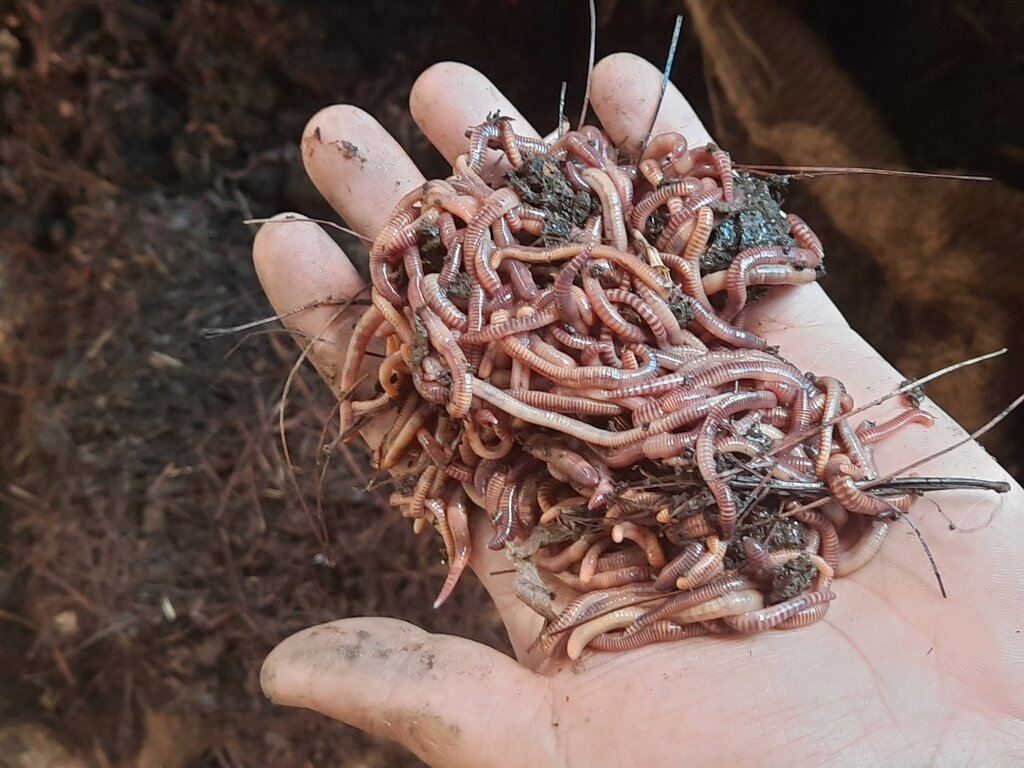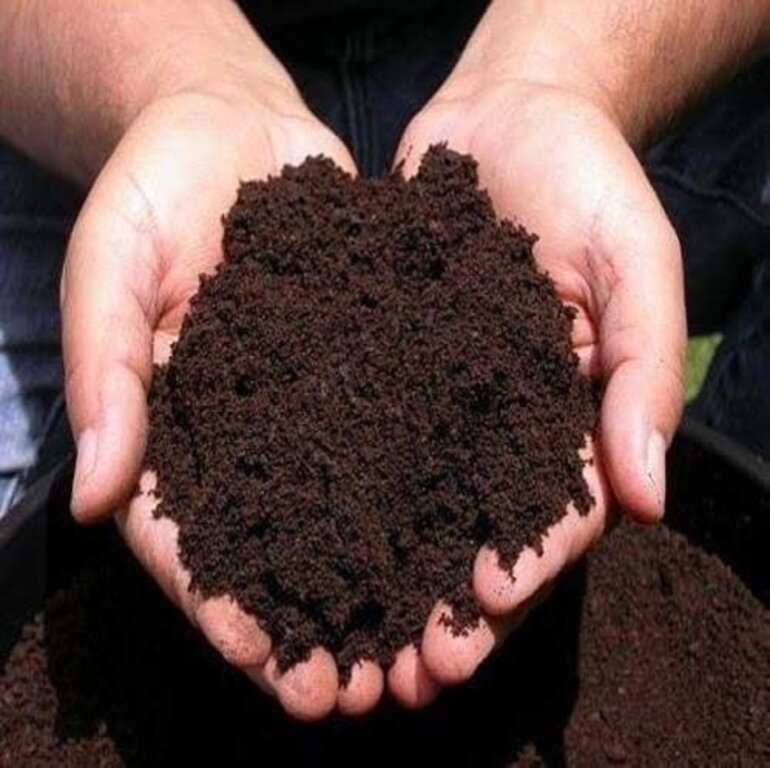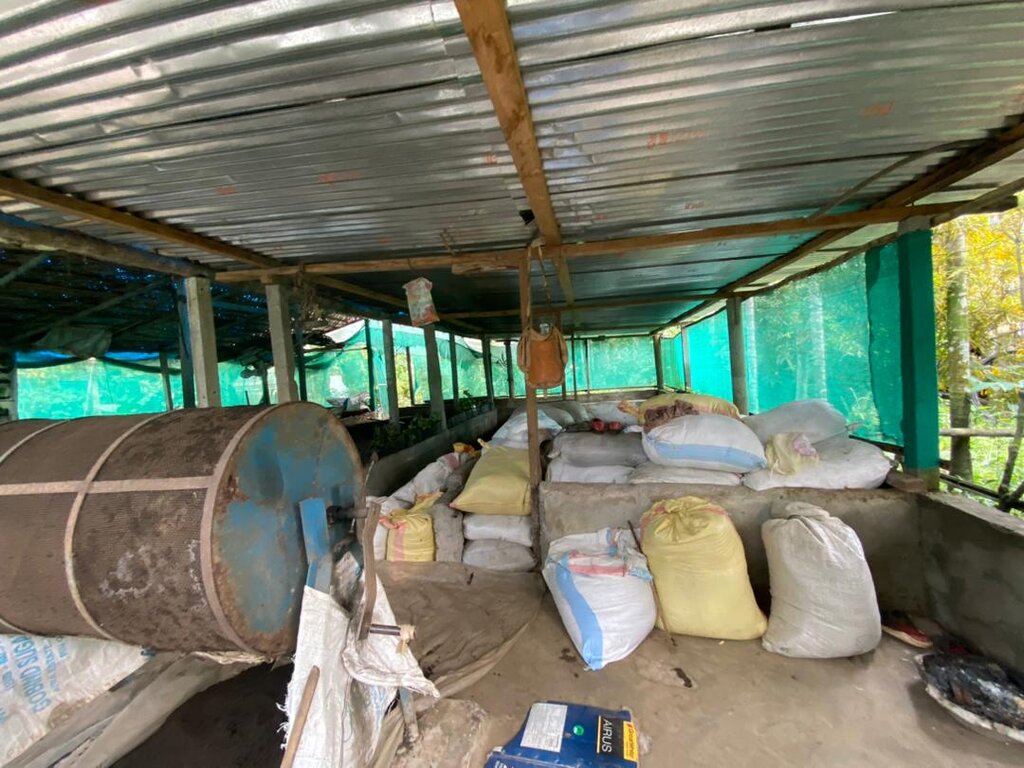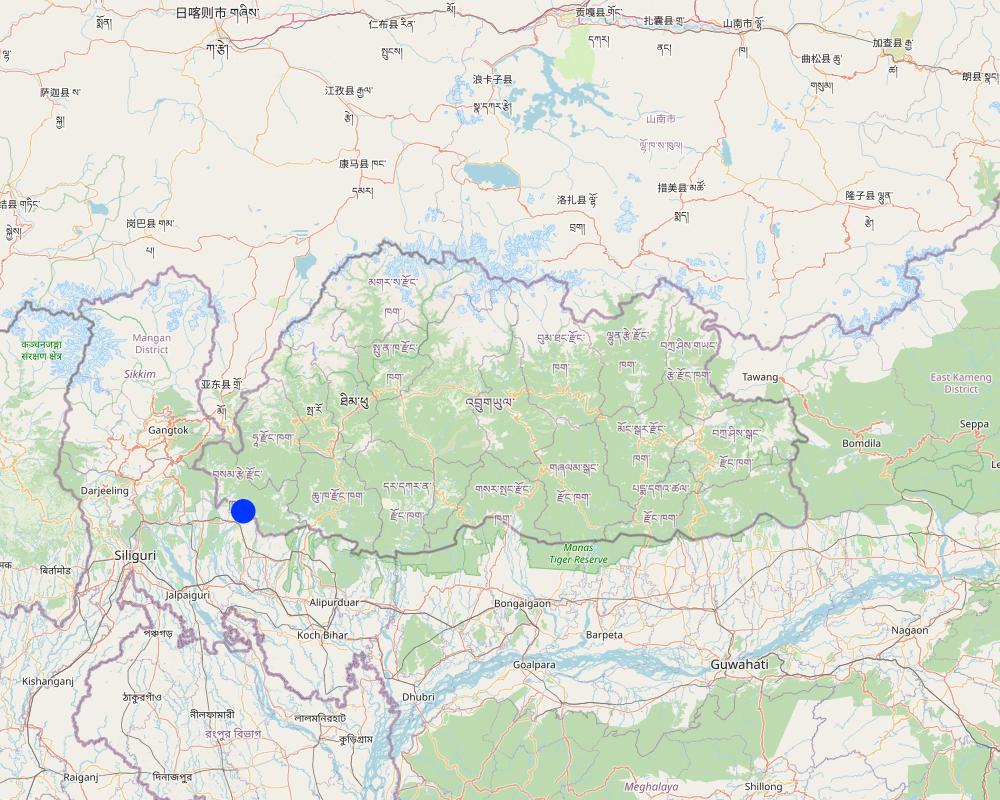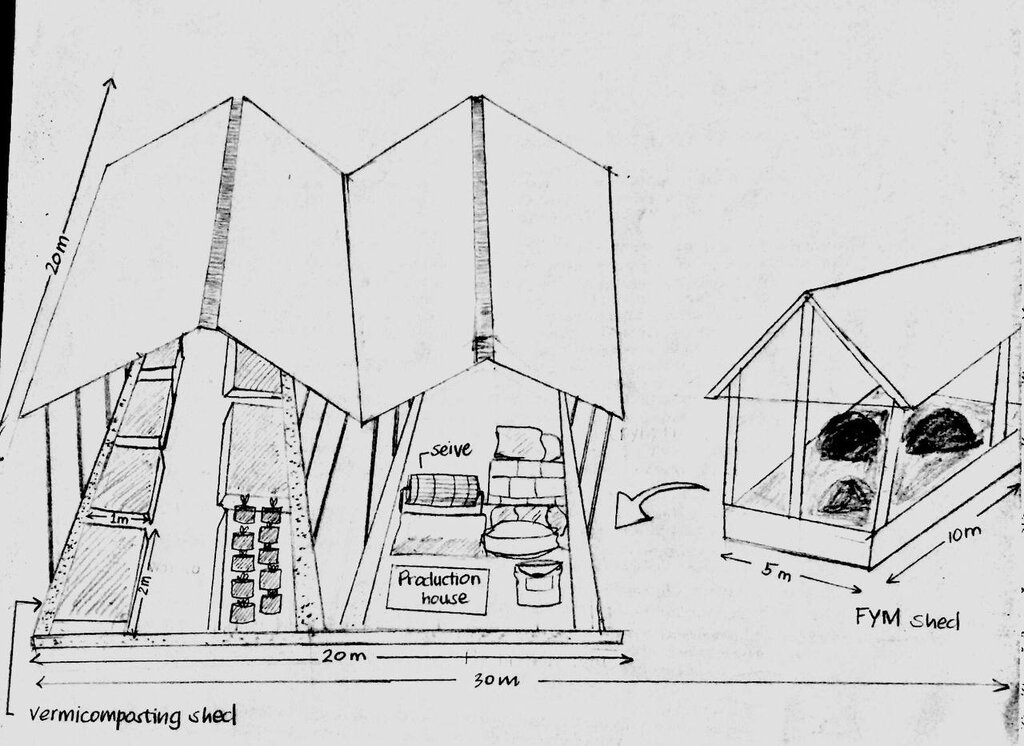Vermicomposting [ภูฏาน]
- ผู้สร้างสรรค์:
- การอัพเดท:
- ผู้รวบรวม: Karma Wangdi
- ผู้เรียบเรียง: Kuenzang Nima
- ผู้ตรวจสอบ: William Critchley, Rima Mekdaschi Studer
Chongboob Lue Zhoni (ལྕོང་འབུབ་ལུད་བཟོ་ནི།)
technologies_6874 - ภูฏาน
ดูส่วนย่อย
ขยายทั้งหมด ย่อทั้งหมด1. ข้อมูลทั่วไป
1.2 รายละเอียดที่ติดต่อได้ของผู้รวบรวมและองค์กรที่เกี่ยวข้องในการประเมินและการจัดเตรียมทำเอกสารของเทคโนโลยี
วิทยากรหลัก
ผู้ใช้ที่ดิน:
Gurung Divya
Norbugang
ภูฏาน
ชื่อของโครงการซึ่งอำนวยความสะดวกในการทำเอกสารหรือการประเมินเทคโนโลยี (ถ้าเกี่ยวข้อง)
Strengthening national-level institutional and professional capacities of country Parties towards enhanced UNCCD monitoring and reporting – GEF 7 EA Umbrella II (GEF 7 UNCCD Enabling Activities_Umbrella II)1.3 เงื่อนไขการใช้ข้อมูลที่ได้บันทึกผ่านทาง WOCAT
ผู้รวบรวมและวิทยากรหลักยอมรับเงื่อนไขเกี่ยวกับการใช้ข้อมูลที่ถูกบันทึกผ่านทาง WOCAT:
ใช่
1.4 การเปิดเผยเรื่องความยั่งยืนของเทคโนโลยีที่ได้อธิบายไว้
เทคโนโลยีที่ได้อธิบายไว้นี้เป็นปัญหาของความเสื่อมโทรมโทรมของที่ดินหรือไม่ จึงไม่ได้รับการยอมรับว่าเป็นเทคโนโลยีเพื่อการจัดการที่ดินอย่างยั่งยืน:
ไม่ใช่
แสดงความคิดเห็น:
This technology does not pose any land degradation problems
2. การอธิบายลักษณะของเทคโนโลยี SLM
2.1 การอธิบายแบบสั้น ๆ ของเทคโนโลยี
คำจำกัดความของเทคโนโลยี:
Vermicomposting is the practice of composting organic waste products with the aid of various types of worms. These worms aid the decomposition of organic materials, including kitchen leftovers and yard trash, resulting in the production of compost that is abundant in nutrients.
2.2 การอธิบายแบบละเอียดของเทคโนโลยี
คำอธิบาย:
Vermicomposting is where organic wastes are broken down by redworms (Eisenia fetida or Lumbricus rubellus) and other types of earthworms. The worms produce nutrient-rich castings, which are valuable natural fertilizers for plants and enhance soil health. Vermicomposting is an effective and environmentally acceptable approach to recycle organic waste and produces a valuable resource for farming and gardening (Grant, 2021).
The raw substrate is initially ground in the gizzard to create smaller particles, increasing the surface area during the vermicomposting process. Earthworm gut microorganisms and digestive enzymes continue to work on the material to create a fine granular product that is rich in healthy nutrients and microbiota (Sharma & Garg, 2017). Vermicomposting is popular in urban gardening and horticulture, where space and resource constraints are common.
It is a sustainable and effective method for managing organic waste because it combines a number of essential traits and components. Firstly, it involves the usage of particular types of earthworms, such Eisenia fetida (red wigglers), which are renowned for their capacity to ingest enormous quantities of organic material. Maintaining optimum moisture levels, typically between 60 and 80 percent, is necessary for efficient vermicomposting. Another crucial component is aeration, which encourages aerobic decomposition and reduces odour. Vermicompost bins or beds are made with sufficient drainage and ventilation systems to do this. The ideal temperature range is between 15 o to 30 o C (Adhikary, 2012). Vermicomposting's goals and functions include waste reduction, improved soil fertility, soil restoration, sustainable agriculture, and easily accessible waste management.
Vermiculture encourages eco-friendly gardening and supports sustainable agriculture methods by limiting the use of chemical fertilizers. The initial expense and time needed to set up a vermicomposting system are two significant drawbacks. Another difficulty is the requirement for constant monitoring and upkeep, including controlling moisture levels, ensuring adequate aeration, and controlling temperature conditions. Poor environmental care can result in bad smells or even the death of earthworms.
Samtse's first and only vermicomposting facility in Norbugang gewog is performing successfully. The project, which began on a couple's farm near Bhimtar in December 2013, employs earthworms to convert organic waste into high-quality compost. It is the end result of the decomposition of organic elements by earthworms. The dzongkhag's assistant agricultural officer (ADAO) spearheaded the idea of establishing the compost plant, with assistance from the national organic program. The main substrate used for vermicomposting is cow dung and banana stems. The mixture is spread out as a bed inside the compost house for the earthworms to feed. The worms break down the mixture to produce vermicompost.
Initially, a kilogram of red earthworms (Eisenia foetida) were cultivated in a nursery. In a month, the nursery produced 10 kg, which was then employed in the project. According to Dibya Gurung, the worms needed 28 days to feed on the organic wastes in the existing compost house environment. Bhutanese farmers utilize vermicompost as a nutrient-rich organic fertilizer to enhance soil fertility and improve crop yields. This promote sustainable agriculture practices and reduce dependence on chemical fertilizers, aligning with Bhutan's goal of achieving food self-sufficiency.
There are currently 12 organic fertilizer producers in the Bhutan producing various types of compost, including vermi-compost, liquid fertilizer, bio-slurry compost, chicken manure, and EM solution. However, there is no record of a dedicated vermiculture enterprise in the nation, even though worms are required to make compost organic fertilizer, according to the National Soil Services Centre (NSSC), Department of Agriculture (DoA). For instance, the country generated 8130MT of organic fertilizers, according to the NSSC's annual report for 2021–2022 (Dorji, 2022).
2.3 รูปภาพของเทคโนโลยี
2.5 ประเทศภูมิภาค หรือสถานที่ตั้งที่เทคโนโลยีได้นำไปใช้และได้รับการครอบคลุมโดยการประเมินนี้
ประเทศ:
ภูฏาน
ภูมิภาค/รัฐ/จังหวัด:
Samtse
ข้อมูลจำเพาะเพิ่มเติมของสถานที่ตั้ง :
Norbugang
ระบุการกระจายตัวของเทคโนโลยี:
- ใช้ ณ จุดที่เฉพาะเจาะจงหรือเน้นไปยังบริเวณพื้นที่ขนาดเล็ก
Is/are the technology site(s) located in a permanently protected area?
ไม่ใช่
Map
×2.6 วันที่การดำเนินการ
ถ้าไม่รู้ปีที่แน่นอน ให้ระบุวันที่โดยประมาณ:
- น้อยกว่า 10 ปี (ไม่นานนี้)
2.7 คำแนะนำของเทคโนโลยี
ให้ระบุว่าเทคโนโลยีถูกแนะนำเข้ามาอย่างไร:
- ทางโครงการหรือจากภายนอก
ความคิดเห็น (ประเภทของโครงการ เป็นต้น) :
National Organic Flagship Program
3. การจัดประเภทของเทคโนโลยี SLM
3.1 วัตถุประสงค์หลักของเทคโนโลยี
- ปรับปรุงการผลิตให้ดีขึ้น
- อนุรักษ์ระบบนิเวศน์
- รักษาสภาพหรือปรับปรุงความหลากหลายทางชีวภาพ
- สร้างผลกระทบทางด้านเศรษฐกิจที่เป็นประโยชน์
3.2 ประเภทของการใช้ที่ดินในปัจจุบันที่ได้นำเทคโนโลยีไปใช้

พื้นที่ปลูกพืช
- Floriculture
Is intercropping practiced?
ใช่
If yes, specify which crops are intercropped:
na
Is crop rotation practiced?
ไม่ใช่
แสดงความคิดเห็น:
Only floriculture is done
3.3 Has land use changed due to the implementation of the Technology?
Has land use changed due to the implementation of the Technology?
- No (Continue with question 3.4)
Land use mixed within the same land unit:
ไม่ใช่
แสดงความคิดเห็น:
floriculture is done
3.4 การใช้น้ำ
การใช้น้ำของที่ดินที่มีการใช้เทคโนโลยีอยู่:
- การชลประทานแบบเต็มรูปแบบ
3.5 กลุ่ม SLM ที่ตรงกับเทคโนโลยีนี้
- การจัดการความอุดมสมบรูณ์ของดินแบบผสมผสาน
- การจัดการของเสีย / การจัดการน้ำเสีย
- สวนครัว
3.6 มาตรการ SLM ที่ประกอบกันเป็นเทคโนโลยี

มาตรการอนุรักษ์ด้วยโครงสร้าง
- S8: การสุขาภิบาลหรือโครงสร้างเกี่ยวกับน้ำเสีย

มาตรการอนุรักษ์ด้วยการจัดการ
- M6: การจัดการของเสีย (การทำ รีไซเคิล การเอากลับมาใช้ใหม่หรือการลดปริมาณ)
3.7 รูปแบบหลักของการเสื่อมโทรมของที่ดินที่ได้รับการแก้ไขโดยเทคโนโลยี

อื่น ๆ
ระบุ:
Improve soil fertility management
แสดงความคิดเห็น:
na
3.8 การป้องกัน การลดลง หรือการฟื้นฟูความเสื่อมโทรมของที่ดิน
ระบุเป้าหมายของเทคโนโลยีกับความเสื่อมโทรมของที่ดิน:
- ลดความเสื่อมโทรมของดิน
- ฟื้นฟูบำบัดที่ดินที่เสื่อมโทรมลงอย่างมาก
4. ข้อมูลจำเพาะด้านเทคนิค กิจกรรมการนำไปปฏิบัติใช้ ปัจจัยนำเข้า และค่าใช้จ่าย
4.1 แบบแปลนทางเทคนิคของเทคโนโลยี
ข้อมูลจำเพาะด้านเทคนิค (แบบแปลนทางเทคนิคของเทคโนโลยี):
The technology is located in five acres land
ผู้เขียน:
Niki Rai
วันที่:
20/07/2023
4.2 ข้อมูลทั่วไปเกี่ยวกับการคำนวณปัจจัยนำเข้าและค่าใช้จ่าย
ให้ระบุว่าค่าใช้จ่ายและปัจจัยนำเข้าได้รับการคำนวณอย่างไร:
- ต่อหน่วยเทคโนโลยี
อื่นๆ หรือสกุลเงินประจำชาติ (ระบุ):
Ngultrum
If relevant, indicate exchange rate from USD to local currency (e.g. 1 USD = 79.9 Brazilian Real): 1 USD =:
250.0
ระบุค่าเฉลี่ยของค่าจ้างในการจ้างแรงงานต่อวัน:
250
4.3 กิจกรรมเพื่อการจัดตั้ง
| กิจกรรม | Timing (season) | |
|---|---|---|
| 1. | Site selection | winter |
| 2. | Collection of raw materials | winter |
| 3. | construction of vermicomposting shed | winter |
| 4. | construction of bricks lined beds for rearing earth worms | winter |
| 5. | Construction of FYM shed | winter |
4.4 ค่าใช้จ่ายของปัจจัยนำเข้าที่จำเป็นสำหรับการจัดตั้ง
| ปัจจัยนำเข้า | หน่วย | ปริมาณ | ค่าใช้จ่ายต่อหน่วย | ค่าใช้จ่ายทั้งหมดต่อปัจจัยนำเข้า | %ของค่าใช้จ่ายที่ก่อให้เกิดขึ้นโดยผู้ใช้ที่ดิน | |
|---|---|---|---|---|---|---|
| แรงงาน | labor | per head | 7.0 | 250.0 | 1750.0 | 50.0 |
| วัสดุด้านพืช | Cow dung | Kg | 5000.0 | 2.0 | 10000.0 | |
| วัสดุสำหรับก่อสร้าง | cement | bag | 145.0 | 290.0 | 42050.0 | |
| วัสดุสำหรับก่อสร้าง | Bricks | piece | 4000.0 | 7.0 | 28000.0 | |
| วัสดุสำหรับก่อสร้าง | Bamboo mat | roll | 10.0 | 3500.0 | 35000.0 | |
| วัสดุสำหรับก่อสร้าง | Green net | roll | 6.0 | 2200.0 | 13200.0 | |
| วัสดุสำหรับก่อสร้าง | Sand | truck | 1.0 | 3500.0 | 3500.0 | |
| วัสดุสำหรับก่อสร้าง | stone | truck | 2.0 | 3500.0 | 7000.0 | |
| วัสดุสำหรับก่อสร้าง | CGI sheet | piece | 25.0 | 1190.0 | 29750.0 | |
| ค่าใช้จ่ายทั้งหมดของการจัดตั้งเทคโนโลยี | 170250.0 | |||||
| Total costs for establishment of the Technology in USD | 681.0 | |||||
ถ้าผู้ใช้ที่ดินรับภาระน้อยกว่า 100% ของค่าใช้จ่าย ให้ระบุว่าใครเป็นผู้รับผิดชอบส่วนที่เหลือ:
National Organic Program
แสดงความคิดเห็น:
For the establishment of this technology National organic program (NOP) funded 50% (Nu 80,000) of the cost and 50% of the cost was invested by the owner
4.5 การบำรุงรักษาสภาพหรือกิจกรรมที่เกิดขึ้นเป็นประจำ
| กิจกรรม | ช่วงระยะเวลา/ความถี่ | |
|---|---|---|
| 1. | construction of production house | winter |
| 2. | Replacement of green net | winter |
4.6 ค่าใช้จ่ายของปัจจัยนำเข้าและกิจกรรมที่เกิดขึ้นเป็นประจำที่ต้องการการบำรุงรักษา (ต่อปี)
| ปัจจัยนำเข้า | หน่วย | ปริมาณ | ค่าใช้จ่ายต่อหน่วย | ค่าใช้จ่ายทั้งหมดต่อปัจจัยนำเข้า | %ของค่าใช้จ่ายที่ก่อให้เกิดขึ้นโดยผู้ใช้ที่ดิน | |
|---|---|---|---|---|---|---|
| แรงงาน | labor | per head | 4.0 | 500.0 | 2000.0 | |
| วัสดุสำหรับก่อสร้าง | cement | bags | 8.0 | 290.0 | 2320.0 | |
| วัสดุสำหรับก่อสร้าง | sand | bolero | 1.0 | 3000.0 | 3000.0 | |
| วัสดุสำหรับก่อสร้าง | pebbles | bolero | 1.0 | 3200.0 | 3200.0 | |
| วัสดุสำหรับก่อสร้าง | Green net | roll | 6.0 | 2200.0 | 13200.0 | |
| ค่าใช้จ่ายทั้งหมดของการบำรุงรักษาสภาพเทคโนโลยี | 23720.0 | |||||
| Total costs for maintenance of the Technology in USD | 94.88 | |||||
ถ้าผู้ใช้ที่ดินรับภาระน้อยกว่า 100% ของค่าใช้จ่าย ให้ระบุว่าใครเป็นผู้รับผิดชอบส่วนที่เหลือ:
NOP
แสดงความคิดเห็น:
The maintenance activity was fully funded by NOP
4.7 ปัจจัยสำคัญที่สุดที่มีผลกระทบต่อค่าใช้จ่าย
ปัจจัยสำคัญที่สุดที่มีผลกระทบต่อค่าใช้จ่ายต่างๆ:
Financial and availability of earthworms
5. สิ่งแวดล้อมทางธรรมชาติและของมนุษย์
5.1 ภูมิอากาศ
ฝนประจำปี
- < 250 ม.ม.
- 251-500 ม.ม.
- 501-750 ม.ม.
- 751-1,000 ม.ม.
- 1,001-1,500 ม.ม.
- 1,501-2,000 ม.ม.
- 2,001-3,000 ม.ม.
- 3,001-4,000 ม.ม.
- > 4,000 ม.ม.
ระบุปริมาณน้ำฝนเฉลี่ยรายปี (ถ้ารู้) :หน่วย ม.ม.
1500.00
ข้อมูลจำเพาะ/ความคิดเห็นเรื่องปริมาณน้ำฝน:
Annual rainfall ranges from 1500 mm to 4000 mm that occurs in monsoon month
ระบุชื่อของสถานีตรวดวัดอากาศที่ใช้อ้างอิงคือ:
National center for hydrology and meteorology
เขตภูมิอากาศเกษตร
Wet subtropical zone
5.2 สภาพภูมิประเทศ
ค่าเฉลี่ยความลาดชัน:
- ราบเรียบ (0-2%)
- ลาดที่ไม่ชัน (3-5%)
- ปานกลาง (6-10%)
- เป็นลูกคลื่น (11-15%)
- เป็นเนิน (16-30%)
- ชัน (31-60%)
- ชันมาก (>60%)
ธรณีสัณฐาน:
- ที่ราบสูง/ที่ราบ
- สันเขา
- ไหล่เขา
- ไหล่เนินเขา
- ตีนเนิน
- หุบเขา
ระดับความสูง:
- 0-100 เมตร
- 101-500 เมตร
- 501-1,000 เมตร
- 1,001-1,500 เมตร
- 1,501-2,000 เมตร
- 2,001-2,500 เมตร
- 2,501-3,000 เมตร
- 3,001-4,000 เมตร
- > 4,000 เมตร
ให้ระบุถ้าเทคโนโลยีได้ถูกนำไปใช้:
- ไม่เกี่ยวข้อง
5.3 ดิน
ค่าเฉลี่ยความลึกของดิน:
- ตื้นมาก (0-20 ซ.ม.)
- ตื้น (21-50 ซ.ม.)
- ลึกปานกลาง (51-80 ซ.ม.)
- ลึก (81-120 ซ.ม.)
- ลึกมาก (>120 ซ.ม.)
เนื้อดิน (ดินชั้นบน):
- ปานกลาง (ดินร่วน ทรายแป้ง)
เนื้อดินล่าง (> 20 ซ.ม.ต่ำจากผิวดิน):
- ปานกลาง (ดินร่วน ทรายแป้ง)
อินทรียวัตถุในดิน:
- ปานกลาง (1-3%)
(ถ้ามี) ให้แนบคำอธิบายเรื่องดินแบบเต็มหรือระบุข้อมูลที่มีอยู่ เช่น ชนิดของดิน ค่า pH ของดินหรือความเป็นกรดของดิน ความสามารถในการแลกเปลี่ยนประจุบวก ไนโตรเจน ความเค็ม เป็นต้น:
MC (%): 92.81
OM (%): 27.93
OC (%):16.24
pH (H20):6.50
EC (µs/cm):259.33
N (%):0.81
P (ppm):2.97
K (mg/100ml):122.07
5.4 ความเป็นประโยชน์และคุณภาพของน้ำ
น้ำไหลบ่าที่ผิวดิน:
ดี
คุณภาพน้ำ (ที่ยังไม่ได้บำบัด):
เป็นน้ำเพื่อการดื่มที่ดี
ความเค็มของน้ำเป็นปัญหาหรือไม่:
ไม่ใช่
กำลังเกิดน้ำท่วมในพื้นที่หรือไม่:
ไม่ใช่
5.5 ความหลากหลายทางชีวภาพ
ความหลากหลายทางชนิดพันธุ์:
- ต่ำ
ความหลากหลายของแหล่งที่อยู่:
- ต่ำ
5.6 ลักษณะของผู้ใช้ที่ดินที่นำเทคโนโลยีไปปฏิบัติใช้
อยู่กับที่หรือเร่ร่อน:
- อยู่กับที่
แนวทางการตลาดของระบบการผลิต:
- ทำการค้า/การตลาด
รายได้ที่มาจากนอกฟาร์ม:
- > 50% ของรายได้ทั้งหมด
ระดับของความมั่งคั่งโดยเปรียบเทียบ:
- รวย
เป็นรายบุคคล/ครัวเรือน:
- เป็นรายบุคคล/ครัวเรือน
ระดับของการใช้เครื่องจักรกล:
- การใช้เครื่องจักรหรือเครื่องยนต์
เพศ:
- หญิง
- ชาย
อายุของผู้ใช้ที่ดิน:
- ผู้เยาว์
- วัยกลางคน
- ผู้สูงอายุ
5.7 Average area of land used by land users applying the Technology
- < 0.5 เฮกตาร์
- 0.5-1 เฮกตาร์
- 1-2 เฮกตาร์
- 2-5 เฮกตาร์
- 5-15 เฮกตาร์
- 15-50 เฮกตาร์
- 50-100 เฮกตาร์
- 100-500 เฮกตาร์
- 500-1,000 เฮกตาร์
- 1,000-10,000 เฮกตาร์
- >10,000 เฮกตาร์
พิจารณาว่าเป็นขนาดเล็ก กลาง หรือขนาดใหญ่ (ซึ่งอ้างอิงถึงบริบทระดับท้องถิ่น):
- ขนาดกลาง
5.8 กรรมสิทธิ์ในที่ดิน สิทธิในการใช้ที่ดินและสิทธิในการใช้น้ำ
กรรมสิทธิ์ในที่ดิน:
- รายบุคคล ได้รับสิทธิครอบครอง
สิทธิในการใช้ที่ดิน:
- รายบุคคล
สิทธิในการใช้น้ำ:
- เกี่ยวกับชุมชน (ถูกจัดระเบียบ)
Are land use rights based on a traditional legal system?
ไม่ใช่
5.9 การเข้าถึงบริการและโครงสร้างพื้นฐาน
สุขภาพ:
- จน
- ปานกลาง
- ดี
การศึกษา:
- จน
- ปานกลาง
- ดี
ความช่วยเหลือทางด้านเทคนิค:
- จน
- ปานกลาง
- ดี
การจ้างงาน (เช่น ภายนอกฟาร์ม):
- จน
- ปานกลาง
- ดี
ตลาด:
- จน
- ปานกลาง
- ดี
พลังงาน:
- จน
- ปานกลาง
- ดี
ถนนและการขนส่ง:
- จน
- ปานกลาง
- ดี
น้ำดื่มและการสุขาภิบาล:
- จน
- ปานกลาง
- ดี
บริการด้านการเงิน:
- จน
- ปานกลาง
- ดี
6. ผลกระทบและสรุปคำบอกกล่าว
6.1 ผลกระทบในพื้นที่ดำเนินการ (On-site) จากการใช้เทคโนโลยี
ผลกระทบทางด้านเศรษฐกิจและสังคม
การผลิต
การผลิตพืชผล
แสดงความคิดเห็น/ระบุ:
The use of vermicompost in crop production offers a sustainable approach to soil fertility management, plant nutrition, disease suppression, and pest control. By harnessing the benefits of vermicompost, farmers can improve agricultural productivity.
การจัดการที่ดิน
แสดงความคิดเห็น/ระบุ:
They can maintain the soil fertility, improve soil structure, retain soil moisture and improve soil health with improved soil micro flora.
รายได้และค่าใช้จ่าย
ค่าใช่จ่ายของปัจจัยการผลิตทางการเกษตร
รายได้จากฟาร์ม
แสดงความคิดเห็น/ระบุ:
Generate more income after the establishment of vermicomposting
ความหลากหลายของแหล่งผลิตรายได้
แสดงความคิดเห็น/ระบุ:
They can use in their own farm (floriculture) and sell to others in market.
ภาระงาน
แสดงความคิดเห็น/ระบุ:
They need more labor for as they have increased their farm size.
ผลกระทบด้านสังคมวัฒนธรรมอื่น ๆ
ความมั่นคงด้านอาหาร / พึ่งตนเองได้
แสดงความคิดเห็น/ระบุ:
Compared to before they are self -sufficient and improved status in the community
สถานการณ์ของกลุ่มด้อยโอกาส ทางด้านสังคมและเศรษฐกิจ
แสดงความคิดเห็น/ระบุ:
They are able to provide job opportunities for others.
ผลกระทบด้านนิเวศวิทยา
ดิน
ความชื้นในดิน
แสดงความคิดเห็น/ระบุ:
The soil they used in their flower potting made of vermicompost content soil moisture.
การหมุนเวียนและการเติมของธาตุอาหาร
แสดงความคิดเห็น/ระบุ:
They can use their kitchen waste for recycling
อินทรียวัตถุในดิน/ต่ำกว่าดินชั้น C
แสดงความคิดเห็น/ระบุ:
The vermicomposting soil contains extra nutrients for gardening.
Specify assessment of on-site impacts (measurements):
They are able to produce rich nutrient soil and from that they can do other business like floriculture.
6.2 ผลกระทบนอกพื้นที่ดำเนินการ (Off-site) จากการใช้เทคโนโลยี
air pollution
แสดงความคิดเห็น/ระบุ:
Foul smell can be challenging to the neighbors
Specify assessment of off-site impacts (measurements):
The vermicomposting can be challenging if there is no market and demand for the products.
6.3 การเผชิญและความตอบสนองของเทคโนโลยีต่อการเปลี่ยนแปลงสภาพภูมิอากาศที่ค่อยเป็นค่อยไป และสภาพรุนแรงของภูมิอากาศ / ภัยพิบัติ (ที่รับรู้ได้โดยผู้ใช้ที่ดิน)
การเปลี่ยนแปลงสภาพภูมิอากาศที่ค่อยเป็นค่อยไป
การเปลี่ยนแปลงสภาพภูมิอากาศที่ค่อยเป็นค่อยไป
| ฤดู | increase or decrease | เทคโนโลยีมีวิธีการรับมืออย่างไร | |
|---|---|---|---|
| อุณหภูมิประจำปี | เพิ่มขึ้น | ไม่ค่อยดี |
6.4 การวิเคราะห์ค่าใช้จ่ายและผลประโยชน์ที่ได้รับ
ผลประโยชน์ที่ได้รับเปรียบเทียบกับค่าใช้จ่ายในการจัดตั้งเป็นอย่างไร (จากมุมมองของผู้ใช้ที่ดิน)
ผลตอบแทนระยะสั้น:
ด้านบวก
ผลตอบแทนระยะยาว:
ด้านบวกอย่างมาก
ผลประโยชน์ที่ได้รับเปรียบเทียบกับค่าใช้จ่ายในการบำรุงรักษาหรือต้นทุนที่เกิดขึ้นซ้ำอีก เป็นอย่างไร (จากมุมมองของผู้ใช้ที่ดิน)
ผลตอบแทนระยะสั้น:
ด้านบวก
ผลตอบแทนระยะยาว:
ด้านบวก
แสดงความคิดเห็น:
Initial set-up cost is expensive and would be challenging if there is no external support.
6.5 การปรับตัวของเทคโนโลยี
- ครั้งเดียวหรือเป็นการทดลอง
ถ้ามีข้อมูลให้บอกปริมาณด้วย (จำนวนของครัวเรือนหรือครอบคลุมพื้นที่):
1
Of all those who have adopted the Technology, how many did so spontaneously, i.e. without receiving any material incentives/ payments?
- 0-10%
แสดงความคิดเห็น:
Only one private vermicomposting site in Samtse
6.6 การปรับตัว
เทคโนโลยีได้รับการปรับเปลี่ยนเมื่อเร็วๆนี้ เพื่อให้ปรับตัวเข้ากับสภาพที่กำลังเปลี่ยนแปลงหรือไม่:
ใช่
ถ้าตอบว่าใช่ ให้ระบุว่าเงื่อนไขการเปลี่ยนแปลงใดที่ถูกปรับตัว:
- การมีแรงงานไว้ให้ใช้ (เนื่องจากการอพยพย้ายถิ่นฐาน)
ให้ระบุการปรับตัวของเทคโนโลยี (การออกแบบ วัสดุหรือชนิดพันธุ์ เป็นต้น):
They have increased the farm size to larger scale from small scale after they got financial support from the Nation Organic Program.
6.7 จุดแข็ง / ข้อได้เปรียบ / โอกาสของเทคโนโลยี
| จุดแข็ง / ข้อได้เปรียบ / โอกาสในทัศนคติของผู้ใช้ที่ดิน |
|---|
| Soil fertility is enhanced and reduce in use of harmful chemicals |
| Farm income generation |
| Can do other business like floriculture |
| จุดแข็ง / ข้อได้เปรียบ / โอกาสในทัศนคติของผู้รวบรวมหรือวิทยากรหลัก |
|---|
| Ecofriendliness |
| Well recognized by other institutions |
6.8 จุดอ่อน / ข้อเสียเปรียบ / ความเสี่ยงของเทคโนโลยีและวิธีการแก้ไข
| จุดอ่อน / ข้อเสียเปรียบ / ความเสี่ยงในทัศนคติของผู้ใช้ที่ดิน | มีวิธีการแก้ไขได้อย่างไร |
|---|---|
| High installment cost | External supports |
| Maintenance requirements | Proper management |
| จุดอ่อน / ข้อเสียเปรียบ / ความเสี่ยงในทัศนคติของผู้รวบรวมหรือวิทยากรหลัก | มีวิธีการแก้ไขได้อย่างไร |
|---|---|
| Long process and challenging to harvest | Systematic process and skilled labor |
| Intensive care | Proper sanitation |
7. การอ้างอิงและการเชื่อมต่อ
7.1 วิธีการและแหล่งข้อมูล
- ไปเยี่ยมชมภาคสนาม การสำรวจพื้นที่ภาคสนาม
3
- การสัมภาษณ์กับผู้ใช้ที่ดิน
1
วันที่เก็บรวบรวมข้อมูล(ภาคสนาม) :
20/07/2023
แสดงความคิดเห็น:
Apart from the business owner we had to contact with other stakeholder like Assistance District Agriculture Officer (ADAO) from Samtse and Gewog Agriculture Extension Officer (GAEO).
7.2 การอ้างอิงถึงสิ่งตีพิมพ์
หัวข้อ, ผู้เขียน, ปี, หมายเลข ISBN:
NSSC Bhutan catalogue of soil and water conservation approaches and technologies, 2012
ชื่อเรื่อง ผู้เขียน ปี ISBN:
Website
หัวข้อ, ผู้เขียน, ปี, หมายเลข ISBN:
Organic fertilizer production manual
ชื่อเรื่อง ผู้เขียน ปี ISBN:
http://dx.doi.org/10.13140/RG.2.2.15894.83521
7.3 Links to relevant online information
ชื่อเรื่องหรือคำอธิบาย:
Vermicompost, the story of organic gold, explaining main features of vermicomposting
URL:
https://doi.org/10.4236/as.2012.37110
ชื่อเรื่องหรือคำอธิบาย:
Vermicomposting, Benefits and drawbacks of vermicomposting
URL:
https://doi.org/10.1016/j.sjbs.2021.02.072
ชื่อเรื่องหรือคำอธิบาย:
Earthworm Vermicompost , Common Vermicomposting Problems.
URL:
https://www.gardeningknowhow.com/composting/vermicomposting/problems-with-vermicomposting.htm
ชื่อเรื่องหรือคำอธิบาย:
Vermicomposting, Main activities involved vermicomposting
URL:
https://www.intechopen.com/chapters/80406
ชื่อเรื่องหรือคำอธิบาย:
Vermicomposting , Purpose of vermicomposting
URL:
https://www.sciencedirect.com/topics/earth-and-planetary-sciences/vermicomposting
ชื่อเรื่องหรือคำอธิบาย:
Vermicomposting, what is vermicomposting
URL:
https://composting.ces.ncsu.edu/vermicomposting-2/
7.4 General comments
N/A
ลิงก์และโมดูล
ขยายทั้งหมด ย่อทั้งหมดลิงก์
ไม่มีลิงก์
โมดูล
ไม่มีโมดูล


